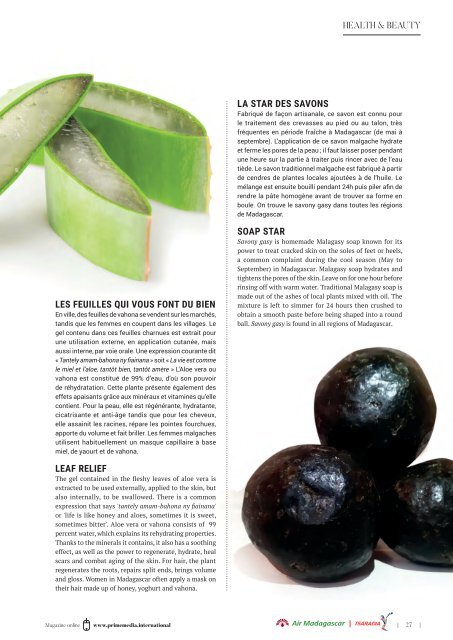Prime Magazine November 2020
You also want an ePaper? Increase the reach of your titles
YUMPU automatically turns print PDFs into web optimized ePapers that Google loves.
HEALTH & BEAUTY<br />
LA STAR DES SAVONS<br />
Fabriqué de façon artisanale, ce savon est connu pour<br />
le traitement des crevasses au pied ou au talon, très<br />
fréquentes en période fraîche à Madagascar (de mai à<br />
septembre). L’application de ce savon malgache hydrate<br />
et ferme les pores de la peau ; il faut laisser poser pendant<br />
une heure sur la partie à traiter puis rincer avec de l’eau<br />
tiède. Le savon traditionnel malgache est fabriqué à partir<br />
de cendres de plantes locales ajoutées à de l’huile. Le<br />
mélange est ensuite bouilli pendant 24h puis piler afin de<br />
rendre la pâte homogène avant de trouver sa forme en<br />
boule. On trouve le savony gasy dans toutes les régions<br />
de Madagascar.<br />
LES FEUILLES QUI VOUS FONT DU BIEN<br />
En ville, des feuilles de vahona se vendent sur les marchés,<br />
tandis que les femmes en coupent dans les villages. Le<br />
gel contenu dans ces feuilles charnues est extrait pour<br />
une utilisation externe, en application cutanée, mais<br />
aussi interne, par voie orale. Une expression courante dit<br />
« Tantely amam-bahona ny fiainana » soit « La vie est comme<br />
le miel et l’aloe, tantôt bien, tantôt amère » L’Aloe vera ou<br />
vahona est constitué de 99% d’eau, d’où son pouvoir<br />
de réhydratation. Cette plante présente également des<br />
effets apaisants grâce aux minéraux et vitamines qu’elle<br />
contient. Pour la peau, elle est régénérante, hydratante,<br />
cicatrisante et anti-âge tandis que pour les cheveux,<br />
elle assainit les racines, répare les pointes fourchues,<br />
apporte du volume et fait briller. Les femmes malgaches<br />
utilisent habituellement un masque capillaire à base<br />
miel, de yaourt et de vahona.<br />
SOAP STAR<br />
Savony gasy is homemade Malagasy soap known for its<br />
power to treat cracked skin on the soles of feet or heels,<br />
a common complaint during the cool season (May to<br />
September) in Madagascar. Malagasy soap hydrates and<br />
tightens the pores of the skin. Leave on for one hour before<br />
rinsing off with warm water. Traditional Malagasy soap is<br />
made out of the ashes of local plants mixed with oil. The<br />
mixture is left to simmer for 24 hours then crushed to<br />
obtain a smooth paste before being shaped into a round<br />
ball. Savony gasy is found in all regions of Madagascar.<br />
LEAF RELIEF<br />
The gel contained in the fleshy leaves of aloe vera is<br />
extracted to be used externally, applied to the skin, but<br />
also internally, to be swallowed. There is a common<br />
expression that says 'tantely amam-bahona ny fiainana'<br />
or 'life is like honey and aloes, sometimes it is sweet,<br />
sometimes bitter'. Aloe vera or vahona consists of 99<br />
percent water, which explains its rehydrating properties.<br />
Thanks to the minerals it contains, it also has a soothing<br />
effect, as well as the power to regenerate, hydrate, heal<br />
scars and combat aging of the skin. For hair, the plant<br />
regenerates the roots, repairs split ends, brings volume<br />
and gloss. Women in Madagascar often apply a mask on<br />
their hair made up of honey, yoghurt and vahona.<br />
<strong>Magazine</strong> online<br />
www.primemedia.international<br />
| 27 |
















